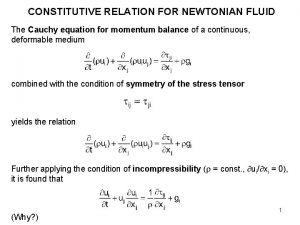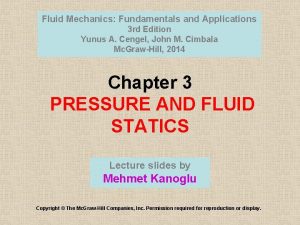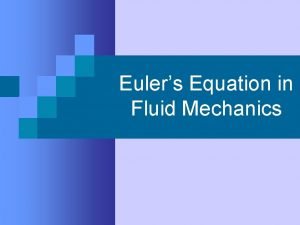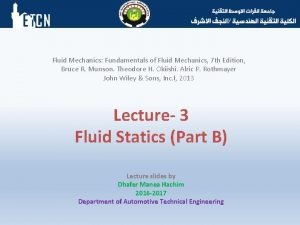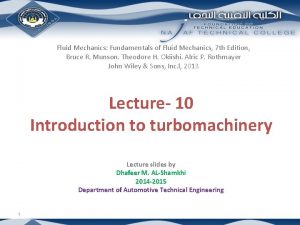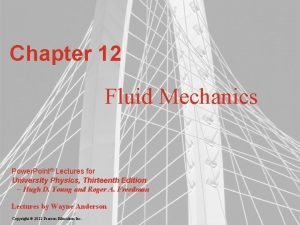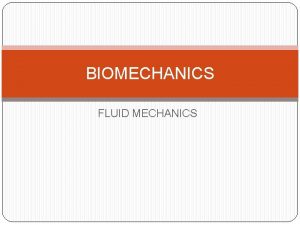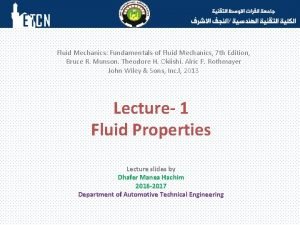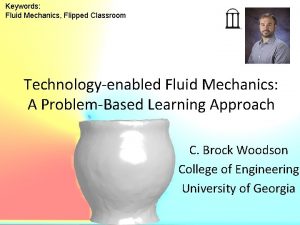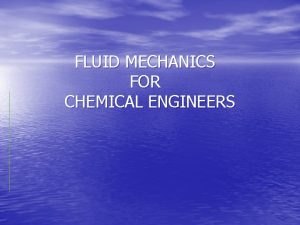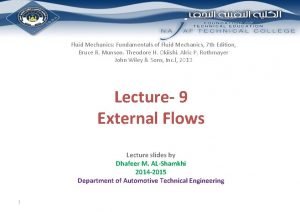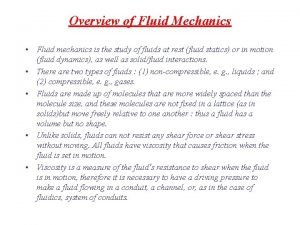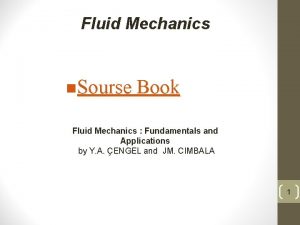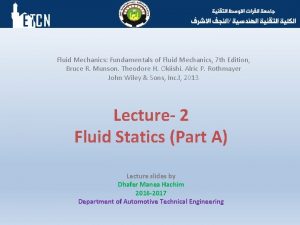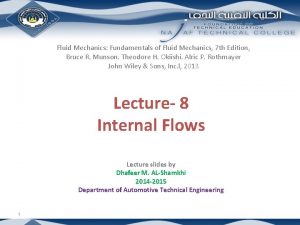CN 2122 CN 2122 E Fluid Mechanics Ti

















- Slides: 17

CN 2122 / CN 2122 E Fluid Mechanics Ti Hwei Chen Rm E 5 02 -19 CN 2122 / CN 2122 E Fluid Mechanics

MODULE LEARNING OUTCOME (for CN 2122) On successful completion of this module, the student will be able to: • Apply dimensional analysis to obtain dimensionless groups for the physical phenomenon, and model theory to predict the behaviour of a system from its dynamically similar system • Explain and find the pressure in static fluids • Apply finite and differential control volume approach of the continuity, momentum and energy equations to solve various fluid flow problems • Describe the concept of inviscid flow and stream function • Examine viscous flow in momentum boundary layer around an immersed object • Perform calculation for a centrifugal pump in a piping system • Describe the effect of operating variables on packed bed and fluidized bed operations CN 2122 / CN 2122 E Fluid Mechanics

MODULE LEARNING OUTCOME (for TCN 2122) On successful completion of this module, the student will be able to: • Apply dimensional analysis to obtain dimensionless groups for the physical phenomenon, and model theory to predict the behaviour of a system from its dynamically similar system • Explain and find the pressure in static fluids • Apply finite and differential control volume approach of the continuity, momentum and energy equations to solve various fluid flow problems • Describe the concept of inviscid flow and stream function • Examine viscous flow in momentum boundary layer around an immersed object • Perform calculation for a centrifugal pump in a piping system • Work in a team to design and conduct experiments with consideration of safety and environmental impact, collect and analyse data and write technical report. CN 2122 / CN 2122 E Fluid Mechanics

Chapter 1 Basic Concepts and Definitions CN 2122 / CN 2122 E Fluid Mechanics

Main Topics ü History of Fluid Mechanics ü Definition of a Fluid ü Continuum Model of a Fluid ü Properties at a Point ü Pressure at a Point in a Static Fluid ü Dimensions and Units CN 2122 / CN 2122 E Fluid Mechanics

1. 0 History of Fluid Mechanics Until the turn of the twentieth century, the study of fluids was undertaken essentially by two groups of people ── Hydraulicians and hydrodynamists. Hydraulicians worked along empirical lines, while hydrodynamists concentrated on analytical lines. The former group provided us lots of information of indispensable value even to the practising engineer of the day. However, lacking the generalizing benefits of workable theory, these results were restricted and of limited value in novel situation. The hydrodynamists, meanwhile, by not availing themselves of experimental information, was found to make such simplifying assumptions as to render their results very often completely at odd with reality. It became clear that the study of fluids must be a blend of theory and experimentation. In 1904, Ludwig Prandtl proposed his Boundary Layer theory which combined the two schools of thought to form Fluid Mechanics. Fluid mechanics is a discipline within the broad field of applied mechanics concerned with the behaviour of liquids and gases at rest or in motion. CN 2122 / CN 2122 E Fluid Mechanics

1. 1 Definition of a Fluid When a shear stress is applied: ü Fluids continuously deform ü Solids deform or bend Fluid is defined to be a substance which must continue to change shape (or to deform), as long as there is a shear stress present (that is a stress tangential to the surface on which it acts) however small. CN 2122 / CN 2122 E Fluid Mechanics

1. 2 Continuum Model It is convenient to think of lumps of fluid containing many molecules and to work with the average statistical properties of such large number of molecules. The detailed molecular structure is thus washed out completely and is replaced by a continuous properties so defined as to ensure that on the macroscopic scale the behaviour of the model duplicates the behaviour of the real fluid. CN 2122 / CN 2122 E Fluid Mechanics

1. 3 Properties at a Point ü 1. 3. 1 Density at a point ü 1. 3. 2 Force at a point Body forces – Weight, electric and magnetic Surface forces – Pressure, Viscous, Others CN 2122 / CN 2122 E Fluid Mechanics

ü 1. 3. 3 Stress at a point Normal and Shear stresses CN 2122 / CN 2122 E Fluid Mechanics

ü 1. 4 Pressure at a Point in a Static Fluid Fig. 1. 4. 1 CN 2122 / CN 2122 E Fluid Mechanics

CN 2122 / CN 2122 E Fluid Mechanics

Point-to-point Variation of Properties in a Fluid Derivation Fig. 1. 4. 2 The geometric meaning of the gradient is that it is a vector having the direction and magnitude of the maximum rate of change of the dependent variable with respect to distance. CN 2122 / CN 2122 E Fluid Mechanics

1. 5 Dimensions and Units Three ideas are involved here: ü Dimensions are treated as algebraic quantities and multiplied or divided accordingly. ü Multiplying or dividing any quantity by 1 does not change its value. ü Any dimensioned equation can be converted to 1 = 1 by dividing through by either side. CN 2122 / CN 2122 E Fluid Mechanics

1. 5 Dimensions and Units Different Unit Systems Conversion between different unit systems • Within same dimension • Across different dimensions (Mass and Force) gc factor Example CN 2122 / CN 2122 E Fluid Mechanics

Points to remember ü Fluid is defined to be a substance which must continue to change shape (or to deform), as long as there is a shear stress present however small. ü The maximum rate of change direction of property is perpendicular to the constant property line. ü The geometric meaning of the gradient is that it is a vector having the direction and magnitude of the maximum rate of change of the dependent variable with respect to distance. ü Unit conversion will normally be carried out between two different unit systems within the same dimension. If conversion has to be taken crossing different dimensions, then relationship involving these dimensions has to be established. ü The introduction of gc factor is to handle difficult situation when same unit is used for two different dimensions. (For example, kgf and kgm, lbf and lbm. ) By bringing in gc, it is as if to declare Force (F) to be another fundamental dimension. CN 2122 / CN 2122 E Fluid Mechanics

Tutorial Link to tutorial 1 CN 2122 / CN 2122 E Fluid Mechanics
 Fy 2122
Fy 2122 Define fluid kinematics
Define fluid kinematics Perihepatic ascites definition
Perihepatic ascites definition Viscoseal
Viscoseal Bioimpedância
Bioimpedância P1-p2
P1-p2 Interstitial vs intracellular
Interstitial vs intracellular Fluid statics deals with fluid at rest
Fluid statics deals with fluid at rest Extracellular fluid and interstitial fluid
Extracellular fluid and interstitial fluid Total body water
Total body water Fluid mechanics fundamentals and applications
Fluid mechanics fundamentals and applications Newtonian
Newtonian Fluid mechanics fundamentals and applications
Fluid mechanics fundamentals and applications Eulerian equation
Eulerian equation Fluid mechanics
Fluid mechanics Hydrostatic force on vertical surface
Hydrostatic force on vertical surface Energy equation with pump
Energy equation with pump Fluid mechanics powerpoint
Fluid mechanics powerpoint











